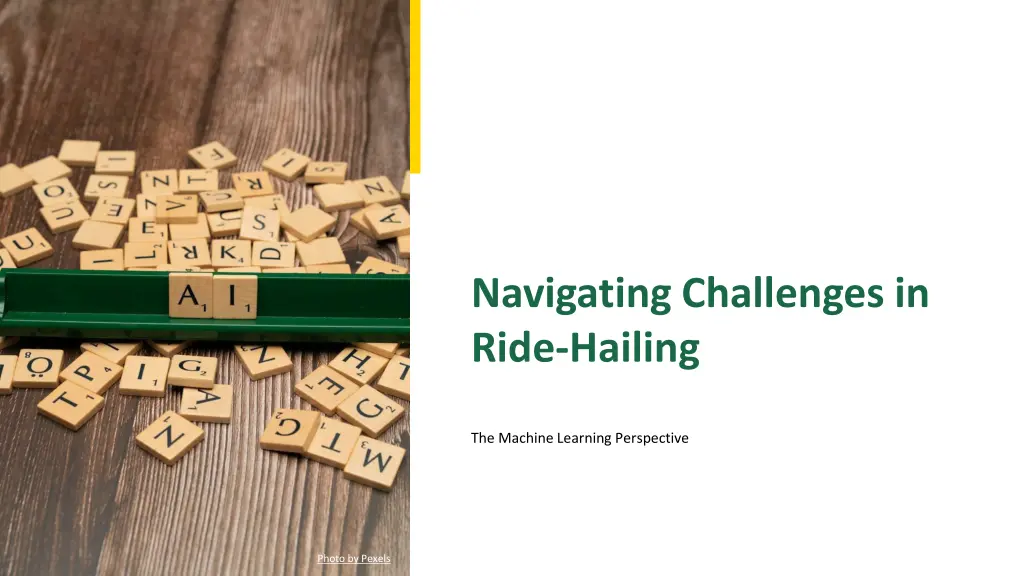
Navigating Challenges in Ride-Hailing: Insights from Machine Learning
Explore the machine learning perspective on navigating challenges in ride-hailing, covering topics such as data drift, algorithms, combatting fake accounts, addressing fraud payments, and managing bad behavior. Discover how Uber and Careem tackle these issues to enhance their services and user experience.
Download Presentation

Please find below an Image/Link to download the presentation.
The content on the website is provided AS IS for your information and personal use only. It may not be sold, licensed, or shared on other websites without obtaining consent from the author. If you encounter any issues during the download, it is possible that the publisher has removed the file from their server.
You are allowed to download the files provided on this website for personal or commercial use, subject to the condition that they are used lawfully. All files are the property of their respective owners.
The content on the website is provided AS IS for your information and personal use only. It may not be sold, licensed, or shared on other websites without obtaining consent from the author.
E N D
Presentation Transcript
Navigating Challenges in Ride-Hailing The Machine Learning Perspective Photo by Pexels
01 Understanding Data Drift Table of Contents 02 Algorithms and Their Impact 03 Combatting Fake Accounts 04 Addressing Fraud Payments 05 Managing Bad Behavior 06 Handling Sudden Cancellations 07 Location Challenges 08 Focus on Uber's Strategy 09 Embracing Change for Growth 10 Thank You!
1 Understanding Data Drift What Is Data Drift? Data drift occurs when the statistical properties of input data change over time, affecting model performance and predictions. This phenomenon can lead to model degradation, making it essential to monitor data distribution continuously. Both input and target variables play a role in this drift, necessitating a robust response strategy. Uber and Careem face this challenge daily, needing to adapt to rapidly shiftingdatasets. Photo by Pexels
2 Algorithms and Their Impact The Backbone of Ride-Hailing Algorithms determine pricing, safety protocols, and user experience, making them crucial for Uber and Careem. They are influenced by various factors including traffic conditions and environmental changes. A well-tuned algorithm can enhance efficiency, but malfunctioningalgorithms can wreak havoc on operations. Ensuring algorithm reliability is a top priority for these companies. Photo by Pexels
3 Combatting Fake Accounts A Real Challenge Fake accounts undermine trust and security in ride-hailing platforms like Uber and Careem. These accounts often lead to increased fraud and a poor user experience. Implementing robust verification processes is essential for maintaining user integrity. Both companies must remain vigilant against this growing threat. Photo by Pexels
4 Addressing Fraud Payments A Financial Risk Fraudulent payments can result in significant financial losses for ride-hailing services. Employing machine learning to detect and prevent fraud is key in safeguarding revenues. Real-time monitoring and analysis contribute to better fraud management strategies. Proactive measures must be taken to combat these financial threats. Photo by Pexels
5 Managing Bad Behavior User Conduct Monitoring Bad behavior from riders or drivers can create a toxic environment,jeopardizing safety. Machine learning can identify patterns of misconduct, enabling timely interventions. Promoting positive behavior is essential for a sustainable ride- hailing ecosystem. Both companies face the challenge of balancing user freedom with accountability. Photo by Pexels
6 Handling Sudden Cancellations A Service Dilemma Sudden cancellations can disrupt service flow and frustrate users and drivers alike. Understanding the causes behind these cancellations helps in developing solid mitigation strategies. Machine learning can help predict cancellation patterns and find solutions. Reducing cancellations improves overall service efficiency and user satisfaction. Photo by Pexels
7 Location Challenges Navigating Dynamic Environments Geographical changes and urban development can affect ride availability and efficiency. Machine learning can help in optimizing routes and improving location accuracy. Understanding local dynamics is vital for meeting customer needs more effectively. Both Uber and Careem must adapt to these changing landscapes constantly. Photo by Pexels
8 Focus on Uber's Strategy Adapting to Change Uber is focusing on enhancing machine learning capabilities to maintain market leadership. Continuous learning models adapt to data changes, ensuring better service delivery. Innovations in algorithms are pivotal for addressing emerging challenges. Adapting to real-time data is the key to staying ahead of the competition. Photo by Pexels
9 Embracing Change for Growth Innovate and Overcome The challenges faced by Uber and Careem are complex but surmountablewith innovation. By leveraging machine learning, these companies can enhance resilience and adaptability. Continuous improvement will lead to sustainable growth in the ride-hailing sector. Embracing change is essential to thrive in the evolving market landscape. Photo by Pexels
10 Thank You! Embrace the Future Thank you for exploring the challenges Uber and Careem face with us today. Together, we can innovate and transform the ride-hailing experience. Your insights are invaluable as we navigate this journey in machine learning. Let's embrace the future of transportation together! Photo by Pexels
